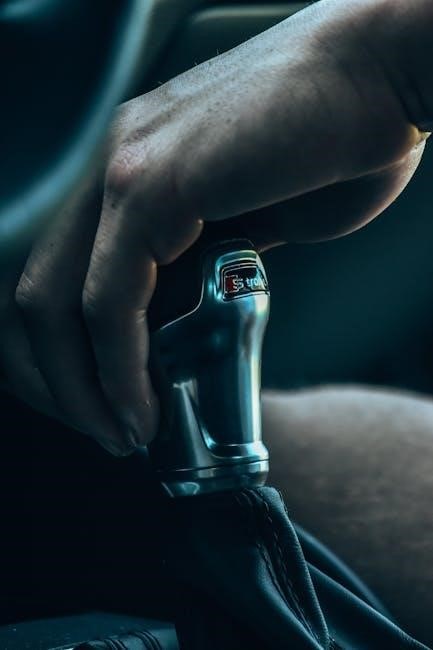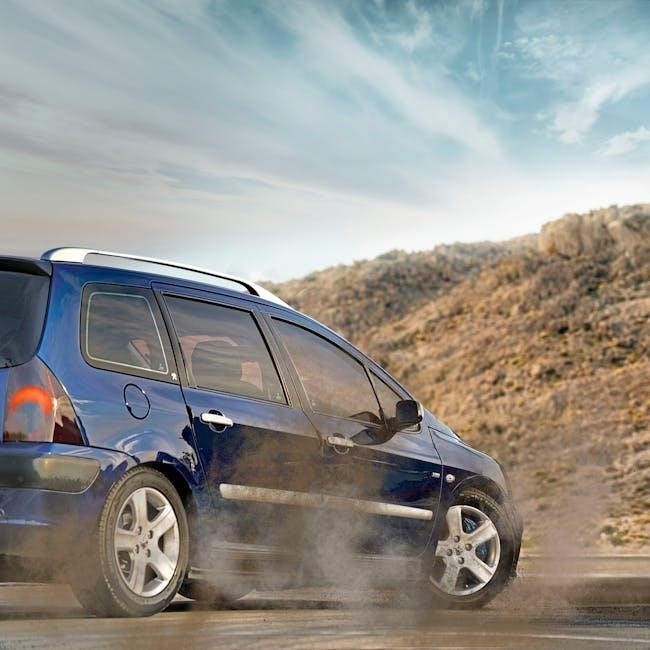The New Jersey Driver Manual, published by the NJ MVC, is a comprehensive guide detailing traffic laws, licensing procedures, and safe driving practices. Available in PDF format, it aids in preparing for driver tests, ensuring a thorough understanding of road rules and regulations.
Purpose and Importance

The New Jersey Driver Manual is designed to provide drivers with essential knowledge to operate vehicles safely and legally. Its primary purpose is to outline traffic laws, road signs, and safe driving practices, ensuring drivers understand their responsibilities. The manual is crucial for new drivers preparing for written and road tests, as it covers licensing procedures, eligibility requirements, and driving rules. It also serves as a refresher for experienced drivers, reinforcing safe habits and legal compliance. By studying the manual, drivers can reduce risks on the road, avoid violations, and contribute to a safer transportation system. The NJ MVC updates the manual regularly to reflect current laws and safety standards, making it a vital resource for all drivers in New Jersey.
Structure and Content
The New Jersey Driver Manual is organized into clear sections, making it easy to navigate. It begins with an introduction to the driver license system, followed by detailed chapters on driver testing procedures, responsibilities, and safe driving rules. The manual covers essential topics such as road signs, traffic signals, right-of-way rules, and defensive driving techniques. Additional sections address car seats, seat belts, DUI laws, and insurance requirements. Appendices provide resources like MVC locations, driver safety tips, and a glossary of terms. The manual is available in multiple languages, including English and Spanish, and can be downloaded as a PDF from the NJ MVC website. Its structured format ensures that all necessary information is accessible, helping drivers prepare for tests and maintain safe driving practices. Regular updates keep the content current with state laws and safety guidelines.
Accessing the Manual
The New Jersey Driver Manual is readily accessible online through the official NJ MVC website. Drivers can download the manual in PDF format free of charge, ensuring easy access to essential information. The manual is available in multiple languages, including English and Spanish, to accommodate all residents. Additionally, an audio version of the manual is provided for individuals who prefer auditory learning. The NJ MVC website offers a user-friendly interface, allowing users to navigate directly to the “Manuals” section and download the latest edition. Hard copies of the manual can also be obtained by visiting a local MVC office. This accessibility ensures that all drivers, whether applying for a new license or renewing an existing one, can conveniently access the resources needed to prepare for tests and stay informed about New Jersey driving laws. Regular updates to the manual are also available online, keeping drivers informed of any changes in regulations or procedures.

The Driver License System in NJ
The New Jersey Motor Vehicle Commission (MVC) oversees the driver license system, providing detailed guidelines for obtaining, renewing, and maintaining licenses. The manual ensures compliance with state traffic laws.
Types of Driver Licenses
The New Jersey Driver Manual outlines various driver license types, including standard driver licenses, probationary licenses for new drivers, and commercial driver licenses (CDLs). A standard license is for personal vehicles, while a CDL is required for operating large trucks, buses, and hazardous material vehicles. The manual also covers specialized licenses, such as motorcycle endorsements, which require additional testing. Additionally, New Jersey offers a Graduated Driver License (GDL) program for young drivers, which includes a learner’s permit and a probationary license before obtaining a full license. The manual details the requirements and restrictions for each license type, ensuring drivers understand the rules and privileges associated with their specific license. This section is essential for applicants to determine which license aligns with their driving needs and to prepare for the necessary exams.
Eligibility Requirements
The New Jersey Driver Manual details the eligibility requirements for obtaining a driver license, emphasizing age, residency, and legal status. Applicants must be at least 16 years old for a learner’s permit, with parental consent required for those under 18. New Jersey residency is mandatory, and applicants must provide proof of identity, Social Security number, and legal presence in the U.S. Vision standards are also outlined, requiring applicants to meet specific visual acuity and field of vision criteria. Additionally, applicants must pass a knowledge test, vision test, and, if applicable, a road test. For commercial licenses, higher age requirements and medical certifications apply. The manual ensures clarity on eligibility to guide applicants through the licensing process effectively, making it a vital resource for understanding the prerequisites for driving in New Jersey.
Application Process
The New Jersey Driver Manual outlines a detailed application process for obtaining a driver license. Applicants must visit an MVC agency, providing required documents such as proof of identity, Social Security number, and New Jersey residency. A completed application form is necessary, and fees must be paid. Vision and knowledge tests are typically required, with a road test needed for certain applicants. The manual specifies different requirements for applying for a standard license, probationary license, or commercial license. Additional documentation may be needed for applicants under 18, including parental consent. The process varies slightly for renewal or duplicate licenses, with streamlined procedures for eligible applicants. The manual ensures clarity on each step, helping applicants navigate the process efficiently and understand what to expect during their visit to the MVC.

Driver Testing Procedures
The NJ Driver Manual details testing procedures, including vision, knowledge, and road tests. These assessments ensure applicants demonstrate understanding of traffic laws and safe driving capabilities before licensure.
Knowledge Test
The Knowledge Test is a critical component of the driver testing process in New Jersey, as outlined in the NJ Driver Manual. This test evaluates an applicant’s understanding of traffic laws, road signs, and safe driving practices. The test consists of multiple-choice questions that cover essential topics such as right-of-way rules, speed limits, and defensive driving techniques. To prepare, applicants are encouraged to study the NJ Driver Manual, which provides detailed information on these subjects. The manual also includes sample questions to help familiarize test-takers with the format and content. Passing the Knowledge Test is a mandatory step toward obtaining a driver’s license in New Jersey. It ensures that applicants have the necessary knowledge to operate a vehicle safely and responsibly. The test is available in multiple languages to accommodate diverse applicants. By studying the manual thoroughly, individuals can gain the knowledge needed to pass the test and progress toward becoming licensed drivers.
Vision Test
The Vision Test is a standard requirement for obtaining a driver’s license in New Jersey, as detailed in the NJ Driver Manual. This test assesses an applicant’s visual acuity and field of vision to ensure they can safely operate a vehicle. During the test, applicants are required to read a vision chart to measure their visual acuity, with or without corrective lenses. The manual specifies the minimum vision standards that must be met. If corrective lenses are needed to meet these standards, the applicant must wear them while driving. The NJ MVC may also test peripheral vision to ensure a wide enough field of view. The Vision Test is a straightforward process but critical for road safety. Applicants who fail may need to consult an eye care professional and provide a medical evaluation to proceed. Proper vision is essential for safe driving, as emphasized in the manual.
Road Test
The Road Test is a critical component of obtaining a driver’s license in New Jersey, as outlined in the NJ Driver Manual. This test evaluates an applicant’s ability to safely operate a vehicle and follow traffic laws. Conducted by an MVC examiner, the test assesses skills such as starting and stopping, turning, merging, and parking. Applicants must provide a properly insured and registered vehicle for the test. The examiner observes adherence to traffic signals, right-of-way rules, and defensive driving techniques. The manual emphasizes the importance of being prepared and familiar with the vehicle’s controls. Common maneuvers include parallel parking, three-point turns, and navigating intersections. Passing the Road Test demonstrates an applicant’s readiness to drive independently. The NJ Driver Manual provides detailed tips and guidelines to help applicants prepare effectively for this crucial step in obtaining their license.

Driver Responsibility
Driver responsibility in New Jersey includes adhering to car seat and seat belt laws, understanding DUI penalties, maintaining proper insurance, and practicing safe driving habits.
Car Seats and Seat Belts
Car seats and seat belts are essential for road safety in New Jersey. The NJ Driver Manual emphasizes that all drivers and passengers must wear a properly secured seat belt. Children under 8 years old or shorter than 57 inches must use an approved car seat or booster seat. Failure to comply with these regulations can result in fines and penalties. The manual also provides guidelines for selecting the correct type of car seat based on a child’s age, weight, and height. Proper installation of car seats is crucial, and resources are available through the NJ MVC to ensure safety. Additionally, the manual highlights the importance of seat belts in preventing injuries and fatalities, reinforcing the state’s commitment to reducing accidents. By following these guidelines, drivers can help protect themselves and their passengers on New Jersey roads.
DUI Laws and Penalties
New Jersey has strict laws against driving under the influence (DUI) of alcohol or drugs. The NJ Driver Manual outlines the legal blood alcohol content (BAC) limit of 0.08% for drivers 21 and older, and zero tolerance for drivers under 21. Penalties for DUI include fines, license suspension, and mandatory installation of an ignition interlock device. First offenses may result in a 3-month to 1-year license suspension, while subsequent offenses lead to harsher penalties, including extended suspensions and potential jail time. Refusal to submit to a breath or blood test also carries severe consequences. The manual emphasizes the importance of never driving under the influence, as it endangers lives and carries significant legal repercussions. Understanding these laws is crucial for responsible and safe driving in New Jersey.
Insurance Requirements
In New Jersey, the NJ Driver Manual outlines mandatory insurance requirements for all drivers. Liability coverage is essential, with minimum limits of $15,000 for bodily injury per person, $30,000 per accident, and $5,000 for property damage. Drivers must also carry Personal Injury Protection (PIP), which covers medical expenses regardless of fault. The manual highlights the importance of maintaining adequate insurance to avoid legal consequences. Driving without insurance can result in severe penalties, including fines, license suspension, and registration revocation. The state offers options like the Basic Policy for lower-income drivers and the ability to reject PIP coverage under specific circumstances. Understanding these requirements ensures compliance with New Jersey law and protects drivers from financial risks associated with accidents.

Safe Driving Rules and Regulations
The NJ Driver Manual emphasizes adherence to speed limits, right-of-way rules, and traffic signals to ensure safe driving practices. It provides clear guidance on these regulations to promote road safety in New Jersey.
Speed Limits
The NJ Driver Manual outlines specific speed limits for various road types, ensuring safe driving practices. Urban areas typically have lower limits, while rural highways allow higher speeds. School zones and construction zones have reduced speed limits to protect vulnerable individuals. The manual emphasizes the importance of adhering to posted speed limits, as they are set based on traffic studies and road conditions. Exceeding these limits can result in fines and license points. Additionally, the manual advises drivers to adjust their speed according to weather conditions, visibility, and traffic congestion. By following these guidelines, drivers contribute to a safer road environment for all users. The NJ MVC enforces these regulations to minimize accidents and promote responsible driving habits across the state. Speed limits are a critical component of New Jersey’s traffic laws, as outlined in the manual.
Right-of-Way Rules
Understanding right-of-way rules is essential for safe and orderly traffic flow in New Jersey. The NJ Driver Manual explains that these rules determine who has the priority to proceed first in various traffic situations. Pedestrians always have the right-of-way in crosswalks, and drivers must yield to them. When approaching a traffic circle or roundabout, vehicles already in the circle have the right-of-way. At four-way stop intersections, the vehicle that arrives first goes first. If two vehicles arrive simultaneously, the driver on the left should yield to the driver on the right. Emergency vehicles, such as ambulances or fire trucks, always have the right-of-way when their lights and sirens are active. Failure to follow these rules can result in traffic citations, fines, or license points. The NJ MVC emphasizes that respecting right-of-way rules is crucial for preventing accidents and ensuring smooth traffic movement. These guidelines are clearly outlined in the manual to help drivers navigate various scenarios confidently and safely.
Traffic Signals and Signs
Traffic signals and signs are critical for maintaining order and safety on New Jersey roads. The NJ Driver Manual details the meanings of various traffic signals, including red, yellow, and green lights, as well as pedestrian signals. It also explains the importance of obeying traffic signs, which are categorized into regulatory, warning, construction, and guide signs. Regulatory signs, such as stop signs and speed limit signs, enforce specific laws. Warning signs, like curve ahead or pedestrian crossing signs, alert drivers to potential hazards. Construction signs indicate temporary conditions, while guide signs provide directional or informational assistance. Understanding these signals and signs is essential for safe driving and avoiding violations. The manual emphasizes that failure to obey traffic signals or signs can lead to accidents, fines, or license penalties. By familiarizing yourself with these indicators, you can navigate roads confidently and responsibly. The NJ MVC manual ensures clarity on these rules to promote safe driving practices.

Defensive Driving Techniques
Defensive driving techniques emphasize anticipating hazards, maintaining safe distances, and being prepared for emergencies to minimize risks and enhance overall road safety.
Anticipating Hazards
Anticipating hazards is a cornerstone of defensive driving, as outlined in the NJ Driver Manual. It involves staying alert to potential risks on the road, such as reckless drivers, pedestrians, or unexpected obstacles. By scanning the road ahead and using mirrors effectively, drivers can identify and prepare for possible dangers before they escalate. The manual emphasizes the importance of maintaining a safe following distance to allow time for reaction. Additionally, being aware of weather conditions, road signs, and the actions of other drivers can significantly reduce the likelihood of accidents. This proactive approach ensures that drivers are better equipped to handle unexpected situations, promoting a safer driving environment for everyone on the road.
Maintaining Safe Distance
Maintaining a safe distance from other vehicles is crucial for preventing accidents, as highlighted in the NJ Driver Manual. A safe following distance allows enough time to react and stop if the vehicle ahead suddenly brakes. The manual recommends using the “two-second rule” as a guideline: choose a fixed object on the road, and ensure that your vehicle passes it at least two seconds after the vehicle in front of you. This distance should be increased in adverse weather conditions, such as rain or fog, or when driving at higher speeds. Tailgating is strongly discouraged, as it significantly reduces reaction time and increases the risk of rear-end collisions. By maintaining an appropriate safety cushion, drivers can better control their vehicle’s stopping distance and reduce the likelihood of being involved in a crash.
Emergency Procedures
In the event of an emergency, the NJ Driver Manual emphasizes the importance of staying calm and taking immediate action to ensure safety. If your vehicle is involved in a crash or breaks down, move to a safe location off the road if possible. Turn on hazard lights to alert other drivers and reduce the risk of further collisions; If the vehicle is operable, carefully guide it to the shoulder or a parking area. In case of a fire, evacuate the vehicle immediately and call 911. The manual also advises keeping an emergency kit in the car, including items like a first-aid kit, flashlight, and reflective triangles. Always notify authorities if the situation involves injuries or significant property damage. Proper emergency procedures help protect both drivers and passengers, minimizing risks during critical situations.

Sharing the Road with Others
Respecting the rights of pedestrians, cyclists, and motorcyclists is crucial. Always yield to pedestrians and use caution when passing cyclists or motorcycles, ensuring safe distances and awareness of their presence.
Pedestrians and Cyclists
Drivers must always yield to pedestrians, especially at crosswalks and intersections. Use extreme caution when approaching areas with high pedestrian traffic. Cyclists have the same rights as vehicles, so share the road and maintain a safe distance. Never pass a vehicle that has stopped for a pedestrian, as this is illegal and dangerous. When turning, check for pedestrians and cyclists in your path. Be patient and avoid aggressive maneuvers. Pedestrians should use crosswalks and follow traffic signals, while cyclists should ride in the same direction as traffic and obey all road signs. Both groups should be visible and aware of their surroundings to ensure mutual safety on the road. Respect and courtesy between drivers, pedestrians, and cyclists are essential for preventing accidents and promoting harmony on New Jersey roads.
Motorcycles and Large Vehicles
Sharing the road with motorcycles and large vehicles requires extra caution. Motorcyclists are more vulnerable, so drivers must be alert and maintain a safe distance. When passing, ensure there is enough space and avoid sudden lane changes. Large vehicles, such as trucks and buses, have blind spots and longer stopping distances. Always check mirrors and blind spots before changing lanes or turning. Never cut off a large vehicle, as this can lead to dangerous situations. Signal clearly and give ample time for these vehicles to react. Motorcyclists should wear helmets and ride defensively, while large vehicle drivers should be patient and aware of their surroundings. Respecting the space and limitations of motorcycles and large vehicles is crucial for safe coexistence on the road. This ensures a harmonious and accident-free environment for all drivers in New Jersey.
School Buses and Emergency Vehicles
When encountering school buses or emergency vehicles, drivers must follow specific rules to ensure safety. School buses display flashing red lights and an extended stop arm to signal stops. All drivers, except those on the opposite side of a divided highway, must stop at least 25 feet away and remain stopped until the lights stop flashing and the stop arm is retracted. For emergency vehicles, such as ambulances, fire trucks, or police cars, with flashing lights and sirens, drivers must yield immediately by pulling over safely to the right side of the road and stopping until the vehicle passes. Pedestrians and cyclists must also be cautious near school buses and emergency vehicles. Failure to comply with these rules can result in severe penalties, including fines and license suspension. These laws prioritize the safety of children, emergency responders, and all road users, preventing accidents and ensuring orderly traffic flow. Always remain vigilant and prepared to react when these vehicles are present.

Additional Resources and Appendices
The NJ Driver Manual includes appendices with MVC locations, driver safety tips, and a glossary of terms. It is available in multiple languages and formats, including PDF, for easy access and study.
MVC Locations
The New Jersey Motor Vehicle Commission (MVC) operates numerous locations throughout the state to provide convenient access to driver services. These locations are listed in the appendices of the NJ Driver Manual, ensuring residents can easily find the nearest facility. The manual provides detailed information about each MVC agency, including addresses, contact details, and operating hours. Whether you need to apply for a driver’s license, renew a vehicle registration, or complete other motor vehicle-related tasks, the MVC locations section helps you plan your visit efficiently. Additionally, the manual directs users to the official MVC website for real-time updates and additional resources. This section is designed to streamline the process of interacting with the MVC, making it easier for drivers to access the services they need. The manual’s appendices also include maps and directions to further assist visitors.
Driver Safety Tips
The New Jersey Driver Manual emphasizes the importance of safe driving practices to reduce accidents and enhance road safety. It provides essential tips for drivers, including staying alert, avoiding distractions, and maintaining a safe distance from other vehicles. The manual also highlights the need to adjust speed according to road conditions, use headlights in low-visibility situations, and exercise extra caution in inclement weather. Additionally, it encourages drivers to regularly inspect their vehicles to ensure proper functioning of brakes, tires, and lights. By following these guidelines, drivers can significantly reduce the risk of accidents and contribute to a safer driving environment. The manual serves as a valuable resource for both new and experienced drivers, offering practical advice to promote responsible and defensive driving habits on New Jersey roads.

Glossary of Terms
The New Jersey Driver Manual includes a glossary of terms to help drivers understand key concepts related to driving laws and regulations. This section defines essential terms such as “Point System,” “Suspension,” “Revocation,” and “Restrictions,” which are crucial for understanding licensing procedures and penalties. It also explains technical terms like “Blood Alcohol Content (BAC)” and “Ignition Interlock Device,” which are relevant to DUI laws. Additionally, the glossary clarifies terms related to vehicle safety, such as “Airbag” and “Anti-lock Braking System (ABS),” ensuring drivers are familiar with modern vehicle features. This resource is designed to provide clarity and ensure drivers comprehend the terminology used throughout the manual, making it easier to navigate and apply the information effectively. The glossary serves as a quick reference guide for both new and experienced drivers seeking to understand complex driving-related terms in New Jersey.
